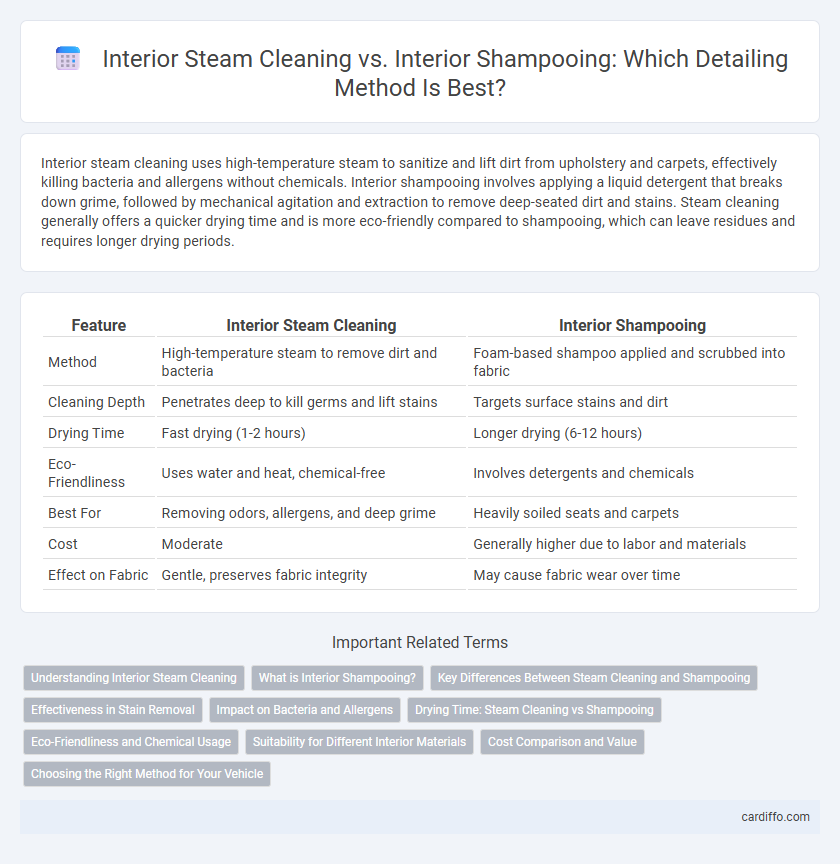Interior steam cleaning uses high-temperature steam to sanitize and lift dirt from upholstery and carpets, effectively killing bacteria and allergens without chemicals. Interior shampooing involves applying a liquid detergent that breaks down grime, followed by mechanical agitation and extraction to remove deep-seated dirt and stains. Steam cleaning generally offers a quicker drying time and is more eco-friendly compared to shampooing, which can leave residues and requires longer drying periods.
Table of Comparison
| Feature | Interior Steam Cleaning | Interior Shampooing |
|---|---|---|
| Method | High-temperature steam to remove dirt and bacteria | Foam-based shampoo applied and scrubbed into fabric |
| Cleaning Depth | Penetrates deep to kill germs and lift stains | Targets surface stains and dirt |
| Drying Time | Fast drying (1-2 hours) | Longer drying (6-12 hours) |
| Eco-Friendliness | Uses water and heat, chemical-free | Involves detergents and chemicals |
| Best For | Removing odors, allergens, and deep grime | Heavily soiled seats and carpets |
| Cost | Moderate | Generally higher due to labor and materials |
| Effect on Fabric | Gentle, preserves fabric integrity | May cause fabric wear over time |
Understanding Interior Steam Cleaning
Interior steam cleaning uses high-temperature steam to effectively remove dirt, bacteria, and odors from car upholstery, carpets, and surfaces without harsh chemicals. This method penetrates deep into fibers, breaking down grime and allergens while promoting a quick drying time. Compared to interior shampooing, steam cleaning is eco-friendly and less likely to cause mold or fabric damage due to minimal water usage.
What is Interior Shampooing?
Interior shampooing involves using specialized cleaning solutions and brushes to deep-clean carpet fibers and upholstery inside a vehicle. This method effectively removes embedded dirt, stains, and odors by scrubbing and extracting debris from fabric surfaces. Interior shampooing restores the appearance and hygiene of carpets and seats, making it a crucial step in comprehensive auto detailing.
Key Differences Between Steam Cleaning and Shampooing
Interior steam cleaning uses high-temperature steam to penetrate upholstery fibers, effectively eliminating dirt, bacteria, and allergens without excessive moisture. Interior shampooing involves applying a foamy detergent followed by scrubbing and vacuuming, which can leave residues and requires longer drying times. Steam cleaning is typically more eco-friendly and faster drying, while shampooing provides deeper stain removal but may risk fabric damage if overused.
Effectiveness in Stain Removal
Interior steam cleaning penetrates deep into fabric fibers using high-temperature steam, effectively loosening and removing tough stains without excessive moisture. Interior shampooing involves applying cleaning agents that break down stains but may leave residues and require longer drying times, potentially leading to mold growth. Steam cleaning is more effective for stubborn stains and offers quicker drying, making it a preferred method for maintaining vehicle interiors.
Impact on Bacteria and Allergens
Interior steam cleaning uses high-temperature vapor to effectively kill bacteria and allergens, offering a deeper sanitization compared to interior shampooing, which primarily removes dirt and stains from upholstery without guaranteed microbial eradication. Steam cleaning penetrates porous surfaces and tight crevices, neutralizing dust mites, mold spores, and pet dander, thereby significantly improving overall cabin air quality. Interior shampooing can leave moisture behind, potentially fostering bacterial growth, whereas steam cleaning ensures faster drying times that minimize allergen retention.
Drying Time: Steam Cleaning vs Shampooing
Interior steam cleaning uses high-temperature vapor that evaporates quickly, resulting in significantly faster drying times--typically within 30 to 60 minutes. Interior shampooing involves applying liquid detergents and scrubbing fabric surfaces, which saturate materials deeply, often requiring 4 to 6 hours or more to dry completely. Faster drying times of steam cleaning reduce the risk of mold and mildew, making it a preferred choice for moisture-sensitive vehicle interiors.
Eco-Friendliness and Chemical Usage
Interior steam cleaning uses high-temperature steam to sanitize vehicle interiors without harsh chemicals, making it a highly eco-friendly option that reduces environmental impact and chemical exposure. Interior shampooing involves applying detergents and foaming agents to clean fabric surfaces, which often requires substantial water use and generates chemical runoff that can harm ecosystems. The steam cleaning process significantly lowers water consumption and eliminates toxic residues, aligning with environmentally sustainable detailing practices.
Suitability for Different Interior Materials
Interior steam cleaning effectively sanitizes and removes odors from leather and fabric seats without causing water saturation or damage, making it ideal for sensitive materials. Interior shampooing suits heavily soiled cloth upholstery and carpeted surfaces by deep cleansing fibers but may risk water absorption leading to mold or shrinkage in delicate fabrics. Choosing the right method depends on material durability and moisture sensitivity, with steam cleaning preferred for delicate interiors and shampooing for robust, fabric-heavy interiors.
Cost Comparison and Value
Interior steam cleaning typically costs less than interior shampooing, ranging between $100 and $150, while shampooing can reach $150 to $250 depending on vehicle size. Steam cleaning uses high-temperature vapor to sanitize and remove grime efficiently, offering excellent value for moderate stains with quicker drying times. Shampooing involves deep scrubbing with detergents, ideal for heavy soiling but incurs higher labor costs and longer drying periods, making steam cleaning a more cost-effective option for general interior detailing.
Choosing the Right Method for Your Vehicle
Interior steam cleaning effectively eliminates dirt, bacteria, and allergens using high-temperature vapor, making it ideal for sensitive fabrics and eco-conscious vehicle owners. Interior shampooing penetrates deep stains and heavy soiling but requires longer drying times and may use chemicals that can affect certain materials. Selecting the right method depends on fabric type, stain severity, and desired drying time to ensure optimal cleanliness and fabric preservation.
Interior Steam Cleaning vs Interior Shampooing Infographic

 cardiffo.com
cardiffo.com